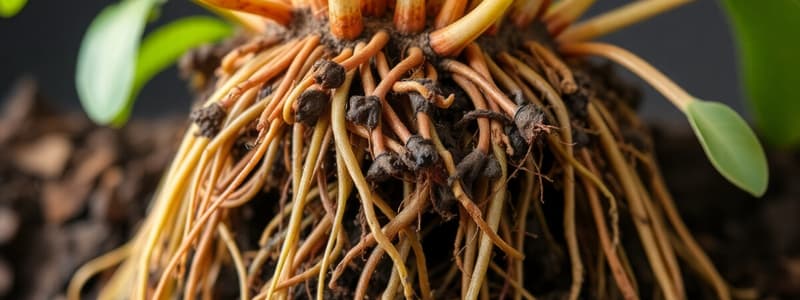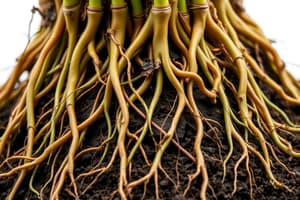Podcast
Questions and Answers
What is the primary function of flagella in eubacteria?
What is the primary function of flagella in eubacteria?
- Nutrient absorption
- Cell division
- Genetic material transfer
- Locomotion (correct)
Only eubacteria can reproduce via binary fission.
Only eubacteria can reproduce via binary fission.
False (B)
What type of prokaryotic cell can act as a donor in conjugation?
What type of prokaryotic cell can act as a donor in conjugation?
F plasmid-positive (F+)
Bacteria that can be transformed are said to be __________.
Bacteria that can be transformed are said to be __________.
Match the following types of prokaryotes with their characteristics:
Match the following types of prokaryotes with their characteristics:
Which mechanism describes the uptake of genetic material from the environment?
Which mechanism describes the uptake of genetic material from the environment?
Chloroplasts have linear DNA similar to that found in eukaryotic cells.
Chloroplasts have linear DNA similar to that found in eukaryotic cells.
What is chemotaxis?
What is chemotaxis?
The process of transferring genetic material via viral infection is called __________.
The process of transferring genetic material via viral infection is called __________.
What supports the endosymbiotic theory?
What supports the endosymbiotic theory?
What is the primary role of roots in plants?
What is the primary role of roots in plants?
Leaves serve multiple functions including heat dissipation and protection against herbivores.
Leaves serve multiple functions including heat dissipation and protection against herbivores.
What type of tissue transports water and minerals from the roots to the shoots?
What type of tissue transports water and minerals from the roots to the shoots?
The main photosynthetic organ in plants is the ______.
The main photosynthetic organ in plants is the ______.
Which type of plant tissue is responsible for transporting sugars?
Which type of plant tissue is responsible for transporting sugars?
Match the following plant tissues with their functions:
Match the following plant tissues with their functions:
Sclerenchyma cells provide flexible support in areas of primary growth.
Sclerenchyma cells provide flexible support in areas of primary growth.
What are the two main types of plant growth mentioned?
What are the two main types of plant growth mentioned?
What is the primary function of the Vascular Cambium in woody plants?
What is the primary function of the Vascular Cambium in woody plants?
The Casparian Strip is responsible for filtering water before it enters the vascular bundle.
The Casparian Strip is responsible for filtering water before it enters the vascular bundle.
What is the function of the root cap in plant growth?
What is the function of the root cap in plant growth?
The __________ is the region where differentiation into dermal, vascular, and ground tissues takes place in roots.
The __________ is the region where differentiation into dermal, vascular, and ground tissues takes place in roots.
Match the following structures with their functions in plant growth.
Match the following structures with their functions in plant growth.
What is the main function of the vascular cambium in woody plants?
What is the main function of the vascular cambium in woody plants?
Stomata are responsible for water loss in plants.
Stomata are responsible for water loss in plants.
What is the purpose of guard cells?
What is the purpose of guard cells?
The _______ theory describes the mechanism of bulk xylem flow due to transpiration.
The _______ theory describes the mechanism of bulk xylem flow due to transpiration.
Match each component of the leaf with its function:
Match each component of the leaf with its function:
Which of the following processes contributes the least to the upward movement of xylem sap?
Which of the following processes contributes the least to the upward movement of xylem sap?
Phloem transports sugars from the leaves to other parts of the plant.
Phloem transports sugars from the leaves to other parts of the plant.
Define the term 'sink' in the context of sugar transport in plants.
Define the term 'sink' in the context of sugar transport in plants.
The _______ cambium produces the periderm as an outer layer.
The _______ cambium produces the periderm as an outer layer.
What triggers the stomatal regulation in plants?
What triggers the stomatal regulation in plants?
Which of the following correctly describes the structures produced by antheridia and archegonia?
Which of the following correctly describes the structures produced by antheridia and archegonia?
Mosses possess stomata in their sporophytes.
Mosses possess stomata in their sporophytes.
What is the main advantage of having a waxy cuticle in vascular plants?
What is the main advantage of having a waxy cuticle in vascular plants?
In hornworts, sporophytes typically live in _____ with cyanobacteria.
In hornworts, sporophytes typically live in _____ with cyanobacteria.
Match the following plant types with their characteristics:
Match the following plant types with their characteristics:
Which of these features is characteristic of ferns?
Which of these features is characteristic of ferns?
All seedless plants reproduce through flagellated sperm that require water.
All seedless plants reproduce through flagellated sperm that require water.
Sporophyte typically extends into the _____ in seedless plants.
Sporophyte typically extends into the _____ in seedless plants.
What type of rhizoids do mosses possess?
What type of rhizoids do mosses possess?
Which plant type typically has flattened gametophytes or resembles mosses?
Which plant type typically has flattened gametophytes or resembles mosses?
Flashcards are hidden until you start studying
Study Notes
Plant Structure and Function
- Nonmotile sperm is characteristic of many plant species.
- Over 300,000 species of plants exhibit a great variety of leaf structures.
Root System
- Absorbs water and minerals essential for plant growth and function.
- Stores carbohydrates; contributes to overall energy management of the plant.
- Primary root emerges first from a germinating seed, with lateral roots branching off.
- Taproots function as the main vertical root, prevalent in tall trees.
Shoot System (Stems and Leaves)
- Functions in gas exchange and photosynthesis, crucial for carbohydrate production.
- Stems support reproductive structures; green stems participate in limited photosynthesis.
- Leaves dissipate heat and offer defense against herbivores and pathogens.
Plant Tissues
- Dermal tissue provides an outer protective covering against damage and pathogens.
- Epidermis acts as a primary protective layer; cuticle reduces water loss.
- Xylem transports water and minerals from roots to shoots, composed of dead cells with lignin.
- Types of xylem cells include tracheids (long, tapered) and vessel elements (short, wide).
- Phloem transports sugars produced in leaves, utilizing living sieve cells that lack a nucleus.
Growth and Development
- Primary growth occurs at apical meristems, leading to elongation of roots and shoots.
- Secondary growth involves lateral meristems that add width to stems and roots.
Prokaryotic Motility and Genetics
- Flagella and pili assist in locomotion, attachment, and conjugation in bacteria.
- Chemotaxis allows bacteria to move toward nutrients or away from harmful substances.
- Conjugation transfers plasmids between prokaryotic cells; transduction and transformation are alternative genetic exchange mechanisms.
- E. coli demonstrates conjugation via F plasmids and R plasmids for antibiotic resistance.
Prokaryotic Metabolism
- Autotrophs include photoautotrophs and chemoautotrophs, while heterotrophs ingest organic substances.
- Aerobes require oxygen, while anaerobes do not. Facultative anaerobes can metabolize with or without oxygen.
Protists and Endosymbiotic Theory
- Endosymbiotic theory explains the origin of mitochondria and chloroplasts from engulfed prokaryotes.
- Protists primarily exist as unicellular organisms, including protozoa and algae.
Leaf Structure
- Epidermis is coated in a waxy cuticle to minimize water loss.
- Stomata allow gas exchange, regulated by guard cells.
- Mesophyll tissue, rich in parenchyma cells, specializes in photosynthesis and gas exchange.
Transport Mechanisms in Plants
- Cohesion-tension theory describes xylem sap movement, driven by transpiration pull.
- Root pressure results from water and minerals being pushed up the xylem.
- Stomatal regulation responds to various environmental cues, including water availability.
- Pressure-flow hypothesis explains the translocation of sugars via phloem due to positive pressure.
Reproduction in Non-Vascular Plants
- Fertilization in liverworts, mosses, and hornworts involves flagellated sperm, water-dependent reproduction.
- The sporophyte stage dominates in vascular plants, while gametophytes emerge from tips.
Seedless Plants
- Sporophyte stage of seedless plants is dominant and photosynthetic.
- Gametangia at gametophyte tips produce gametes for reproduction.
- Lycophytes and pterophytes possess distinct features like branching stems and feathery fronds.
Anatomy of Root Growth
- Root cap protects the apical meristem; growth occurs in defined zones.
- Endodermis regulates water and nutrient flow using the Casparian strip for filtration.
Stem Structure
- Epidermis combined with a waxy cuticle serves to prevent desiccation.
- Vascular bundles differ in arrangement between monocots (rings) and dicots (dispersed).
- Cork cambium and vascular cambium contribute to secondary growth, increasing girth in stems and roots.
Studying That Suits You
Use AI to generate personalized quizzes and flashcards to suit your learning preferences.




